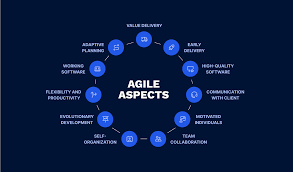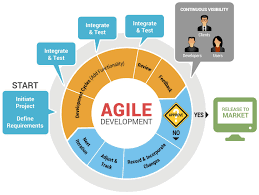Exploring the Evolution of XP Development Methodologies
The Evolution of XP Development
Extreme Programming (XP) is a software development methodology that has evolved over the years to meet the changing needs of the industry. Originally introduced in the late 1990s, XP has since undergone various transformations and adaptations to remain relevant in today’s fast-paced technological landscape.
Core Principles of XP
XP is based on a set of core principles that emphasize collaboration, flexibility, and continuous improvement. These principles include:
- Communication
- Simplicity
- Feedback
- Courage
- Respect
Evolution of XP Practices
As software development practices have evolved, so has XP. Over the years, new practices and techniques have been incorporated into XP to enhance its effectiveness. Some of the key practices that have emerged include:
- Test-Driven Development (TDD)
- Pair Programming
- Continuous Integration
- Refactoring
- User Stories
The Future of XP Development
In today’s rapidly changing technological landscape, XP continues to adapt and evolve. With the rise of Agile methodologies and DevOps practices, XP development is becoming more integrated into larger software development processes. The future of XP development lies in its ability to remain agile, flexible, and responsive to the needs of modern software projects.
Overall, the evolution of XP development reflects the dynamic nature of software development as a whole. By staying true to its core principles while embracing new practices and techniques, XP remains a valuable approach for teams looking to deliver high-quality software efficiently and collaboratively.
Understanding Extreme Programming (XP): Key Concepts and Practices Explained
- What is Extreme Programming (XP) development?
- What are the core principles of XP development?
- How does Test-Driven Development (TDD) fit into XP development?
- What is Pair Programming and how is it used in XP development?
- Why is Continuous Integration important in XP development?
- How does Refactoring contribute to XP development practices?
- Can you explain the concept of User Stories in the context of XP development?
What is Extreme Programming (XP) development?
Extreme Programming (XP) development is a software development methodology that emphasizes collaboration, feedback, and continuous improvement. In XP, teams work closely together to deliver high-quality software in a flexible and adaptive manner. Key practices of XP include Test-Driven Development (TDD), Pair Programming, Continuous Integration, Refactoring, and User Stories. By following the core principles of communication, simplicity, feedback, courage, and respect, XP aims to streamline the development process and ensure that software meets the evolving needs of users effectively.
What are the core principles of XP development?
The core principles of Extreme Programming (XP) development are fundamental values that guide the methodology’s approach to software development. These principles include communication, simplicity, feedback, courage, and respect. Communication emphasizes the importance of effective collaboration among team members. Simplicity advocates for keeping processes and solutions straightforward and easy to understand. Feedback encourages continuous improvement through regular assessments and adjustments. Courage promotes taking risks and making necessary changes to achieve project goals. Respect underscores the significance of valuing all team members’ contributions and perspectives in the development process. These core principles form the foundation of XP development, shaping how teams work together to deliver high-quality software efficiently.
How does Test-Driven Development (TDD) fit into XP development?
Test-Driven Development (TDD) is a fundamental practice within Extreme Programming (XP) development methodology. In TDD, developers write tests before writing the actual code, following a cycle of writing a failing test, implementing the code to pass the test, and then refactoring the code. This iterative process ensures that the codebase remains robust and well-tested throughout the development lifecycle. TDD aligns perfectly with XP’s core principles of simplicity, feedback, and continuous improvement by promoting early testing, rapid feedback loops, and a focus on delivering working software incrementally. By incorporating TDD into XP development, teams can enhance their ability to produce high-quality software that meets both functional requirements and customer expectations.
What is Pair Programming and how is it used in XP development?
Pair Programming is a collaborative software development technique used in Extreme Programming (XP) where two programmers work together at one workstation. In Pair Programming, one programmer writes the code while the other reviews each line as it is typed, providing real-time feedback and catching errors early on. This practice promotes knowledge sharing, improves code quality, and enhances team communication. Pair Programming is a key practice in XP development as it encourages continuous collaboration and ensures that the codebase is thoroughly reviewed and tested throughout the development process.
Why is Continuous Integration important in XP development?
Continuous Integration is a crucial aspect of Extreme Programming (XP) development because it promotes early and frequent integration of code changes from multiple developers into a shared repository. By automatically merging code and running automated tests regularly, Continuous Integration helps detect and resolve integration issues quickly, ensuring that the software remains stable and reliable throughout the development process. This practice enhances collaboration among team members, reduces the risk of conflicts, and allows for faster feedback on the quality of the codebase, ultimately leading to a more efficient and productive software development workflow in XP projects.
How does Refactoring contribute to XP development practices?
Refactoring plays a crucial role in Extreme Programming (XP) development practices by enabling teams to continuously improve the design and maintainability of their codebase. Through refactoring, developers can make small, incremental changes to the code without altering its external behavior. This process helps enhance code clarity, reduce complexity, and eliminate technical debt, ultimately leading to a more robust and flexible software system. In XP, refactoring is integrated into the development workflow, encouraging teams to regularly refine their codebase to ensure it remains efficient and adaptable to changing requirements. By prioritizing refactoring as a fundamental practice, XP teams can achieve higher levels of code quality and sustainability throughout the software development lifecycle.
Can you explain the concept of User Stories in the context of XP development?
In the context of Extreme Programming (XP) development, User Stories are concise, user-focused descriptions of features or functionalities that capture the requirements from the end user’s perspective. These stories serve as a communication tool between developers and stakeholders, emphasizing collaboration and understanding of what needs to be built. By breaking down complex functionalities into small, manageable units, User Stories help prioritize tasks, promote iterative development, and ensure that the software meets the users’ needs effectively. This agile approach allows for flexibility and adaptability throughout the development process, enabling teams to deliver value incrementally and respond to changing requirements efficiently.










